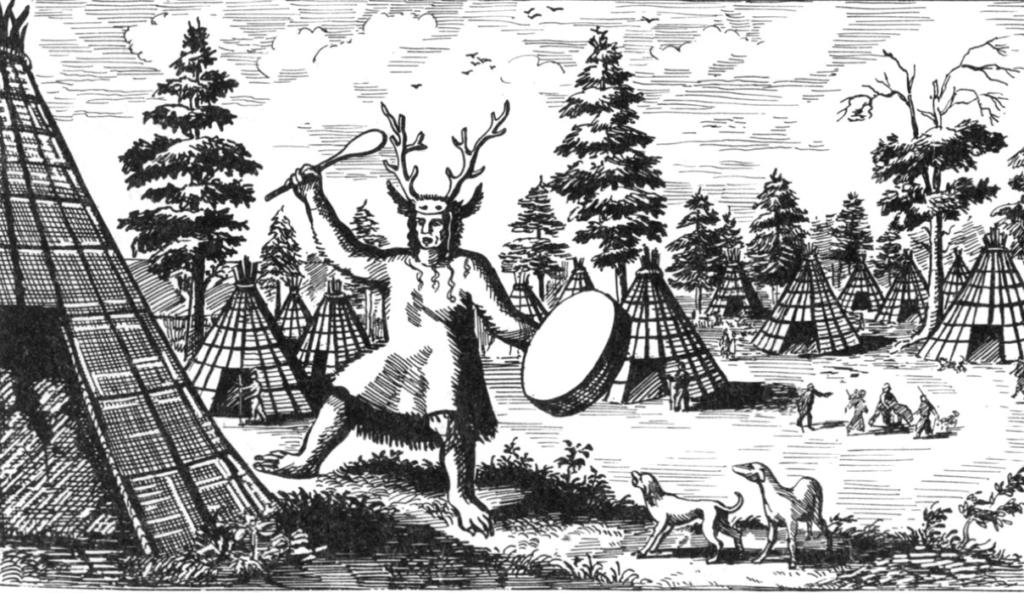Follow the Glowing Red Antlers:
Re-Encountering Shamanism
The gods have a sense of humor. Brad was taken last summer to a spiritual classroom in which he was unambiguously reintroduced to a word that we had just wiped clean from our website (due to its connotative baggage). Here is our report:
I (Brad) dreamed of arriving at a gigantic hotel complex with multiple towers and endless rooms. It resembled the kind of place where large conferences are held. While wandering the halls I became worried that I wouldn’t be able to remember how to get back to my room because the place was so large. My mother then suddenly appeared and was unsure where her room was located. As I helped her find her way, I grew concerned that if we drifted too far apart we’d both get lost.

A bit further down the main hall was a large foyer where doors opened to several ballrooms that caught my curiosity. Inside there were presentations going on that reminded me of the psychotherapy, self-help, and spiritual workshops that are popular in our time. They had the obvious scent of slick fakery and blatant hucksterism. I could hear the promoters ridiculously oversimplify complex topics while making false promises about quick and easy spiritual mastery. I heard one presenter claim he could teach people to conduct shamanic healing after a two-day workshop and that they would be able to instantly alter their consciousness in less than nine minutes using his technique.
As I stood in the hallway eavesdropping, I was approached by a man wearing a long formal black coat. He seemed familiar, though I could not remember where I had met him before. Perhaps he had been a professor or researcher at MIT, or someone I met in my earlier college student years. Or was it someone from over a century or two ago, because the coat seemed extremely old and not of our time? I could not clearly place the identity of this mysterious man.
Before I could speak to him, a woman in the hallway recognized me and ran up to ask for a hug. I was a bit embarrassed because I did not recall who she was. I reluctantly hugged her and she replied, “You’re not moving.” This made me wonder whether she was someone who had long ago attended one of my shaking medicine gatherings. I used to ecstatically hug everyone like a Kalahari Bushman doctor and administer “the shake.” With this memory in mind, I proceeded to activate the sacred vibration within me and gave her one of those special shaking hugs.
As I felt the energy surge inside me I was suddenly struck by what felt like a bolt of lightning hitting the base of my spine. I could feel that someone behind me was staring and beaming some kind of strong energy into my body. I quickly turned around and saw a middle-aged woman looking right at me, dressed in some kind of ceremonial attire. She seemed to be Mongolian or Siberian, but I wasn’t exactly sure of her cultural origin. She was wearing a colorful jacket with many decorative buttons. The woman stared at me with fiercely blazing eyes, but what stunned me most was the full set of glowing red antlers that seemed to grow right from the top of her head.
When our eyes met both time and space disappeared. After holding her gaze she suddenly turned and exited through a door that appeared out of thin air. An elderly man who had been standing behind her then approached me. He was also traditionally dressed in a similar kind of jacket. I asked him, “Who was that woman? I saw glowing red antlers above her head.” He replied, “She is a shaman.” Without missing a beat, I replied, “I am also a shaman.” I was surprised that I said this in such a matter of fact way because I normally do not use that term when referring to myself. The man said, “Yes I know that you are a shaman because you were able to see her antlers.” He then turned and exited through the same mystery door. I stood there suspended in the deep recognition of the course my life had taken and that I had actually become a shaman.
Just then the man in the long black coat who had witnessed my exchange with the shaman came up and handed me a piece of paper with his contact information. He said, “The water has been released and it has started to flood. It’s too late to take your mother back to your childhood home. That area is already covered by floodwater. You will have to find another path. If you get lost and need help, please call me. I can help you find where you need to go.”
I woke up from the dream still trembling at the sight of the shaman’s glowing red antlers. What shamanic culture did she belong to—Evenk, Tuva, Buryat? I believe that she was one of the reindeer people, most likely Evenk, formerly known as the Tungus.

I also wondered about the man in the long black coat who had offered me guidance. He reminded me of the scientists I had known at MIT, but he also seemed to be someone else. I was suddenly overtaken with the idea that it was Reverend Joseph Hart.[1] This idea came from nowhere and it startled me. I was excited because perhaps I had actually seen his face in the visionary realm. No paintings or sketches remain of Hart’s portrait so it is a mystery as to what he looked like.
I then remembered my recent episodes of poly-dreams where different people were combined as one unity. I concluded that this man with the long coat was most likely another hybrid figure—a mix of a typical MIT scientific scholar with the equally profound religious scholar, Joseph Hart. It’s no surprise that such a hybrid figure would be the one to offer us help in case we got lost, because Hillary and I sometimes turn to the scholarship of MIT cyberneticians like Warren McCulloch and Norbert Weiner to sort out various conceptual knots and impasses. In addition, we equally lean on the spiritual pointing that Reverend Hart left the world through his brief and powerful autobiography.
When I reported the dream to Hillary the next morning we both laughed because the night before we had removed the word “shamanism” from our website. We had long felt unsure about using this word due to its misuse and misappropriation, not to mention all the confusion scholars have found or further bred with respect to its definition, phenomenology, and limitation or extension of descriptive use. In addition, most varieties of neo-shamanism perpetuate certain connotations and assumptions about healing and visionary experience that are antithetical to our own experience of diverse shamanic traditions and sacred ecstasy. Yet, in spite of the muddle surrounding shamans and scholars of shamanism, the dream reminded us that the word shaman still belongs to a sacred mystery that is bigger and more powerful than our preferences for or against any name or elaborated explanation. We therefore put the word shamanism back on our website, for no other reason than we trust the teachings that come from the spiritual classrooms more than anyone’s trickster mind, including our own.
What’s In a Name?
We know that the term shaman came from the Evenki word saman that refers to someone excited and ecstatically moved by an inner fire.[2] In other words, shamanism involves the same underlying phenomenon as Sacred Ecstatics—igniting a fire in the soul. It has nothing to do with the later developed practice of sitting or lying down to induce a hypnotic daydream via a monotonous rhythm, absent of inner fire and its heated expression.
Pop culture shamans are not the Ma and Pa shamans of old. Authentic shamanism—the hard-earned rather than weekend-learned technical art of sacred ecstasy— is unpredictably wild and even the drumbeat itself constantly alters its tempo, duration, volume, and presence. Sacred songs are also central to shamanic experience, and so are all kinds of changing tones and uncommon sound making, along with spontaneous movement and dance. Shamanism was once upon a time a wild and improvised performance rather than a tamed-for-the-masses-easily-caught-and-taught routine.
There likely has never been a pure, stable, standardized, core form of “shamanism” because shamans were governed by the numinous world of spirit and this assured constant change, expansion, and complexity of understanding and practice. In addition, long histories of human migration meant that shamans would often incorporate elements of other religions including Christianity, Buddhism, and Islam. This even occurred in Mongolia and Siberia, regions many ethnographers look to find the roots of shamanism. Whatever shamanism was in the beginning, it soon became a rolling syncretic stone that gathered whatever mystery fed its fire and kept its place in the unknown. As soon as shamanism is claimed to be classifiable, reproducible, or easily understandable and teachable, it is arguably no longer shamanism.

Sacred Ecstatics recognizes that discussions of shamanism can serve the attainment of ecstasy if and only if they evoke spiritual fire and vast mystery. It is the expansion rather than reduction of shamanism that gives it life, the latter being assured when anything is free to change, especially the shaman. Here the names shaman, mystic, and healer (as well as drummer, musician, singer, and dancer) were never meant to be rigidly distinct roles. It is likewise unnecessary to pedantically differentiate shamanic experience from trance (whether verbal, nonverbal, singular focus, multiple focus, or kinetic), possession, mediumship, and the like. All these names and descriptions represent the changing faces or momentary phases of the same inner fire, the heat within that shakes the body, awakens the higher senses, and mystically opens the heart rather than only tickles the imagination.
More than anything, shamanism involves allowing the world of spirit to have its way with you. This may include receiving a vision that reminds you to turn around and take another look at that which you have left behind. The more attached you are to stabilizing ideological, sensory, aesthetic, cultural, intellectual, or spiritual preferences, the more distant you are from sacred mystery. Spiritual experience is a dynamic changing process, not a static noun that perpetuates cliché action. A cooked shaman is unashamedly free to find temporary residence in any religious dwelling, tent, tavern, or theatre that has been touched by the ecstatic fire. Shamans on fire are syncretic mixers of spiritual heat rather than identity fixers of ice-cold names.
Follow the Glowing Fire
We have distanced ourselves from the names “shaman” and “shamanism” simply because we feel they are no longer good signposts for lost people trying to spiritually find their way home. But dreaming of the woman with the glowing red antlers reminded us that it is the presence of spiritual fire rather than the absence of cold names that keeps us on track. Are we spiritually hot or cold? That is the most important question. Asked differently: Are we filled with the red-hot sacred emotion and vibration that makes us tremble? If the answer is yes, then we are near the same fire that makes a shaman’s antlers glow, a mystic’s heart sing, and gives life to a healer’s hands.
Join us in the sacred ecstatic exodus from the spiritual cold, whether it’s new or old age, academic or spiritual. We can no longer return to our past home in any historical time zone because the waters have been released. The original technicians of fiery ecstasy have been obscured and barred from modern-day spiritual seekers by technicians of refrigeration. Welcome back the heat that defeats all schemes of classification and opens the way for dreams that sing, swing, and ring the higher ecstatic truths.
Follow the guides and tracks of clear thinking and singular rope dedication, the scholarly heart and the sacred Hart that help us not get lost in the labyrinth of distraction with its promises of instant magical attraction. Above all else, follow the glow of the ecstatic embers, the vibration of the shaking hugs, and the zap of the higher power lightning bolts. In the midst of the spiritual sales pitches, the ancestral shamans are behind you, transmitting what has been forgotten—the shamanic way of working with what resides above the head, the highest source and force of creation. Turn around and look—there you’ll see the fire that won’t let an old shaman retire.
– The Keeneys, August 2018
[1] For more on the dream that led us to Joseph Hart, see Climbing the Rope to God: Mystical Testimony and Teaching.
[2] Casanowicz, I.M. (1926). Shamanism of the Natives of Siberia. Washington D.C.: Smithsonian Report.
